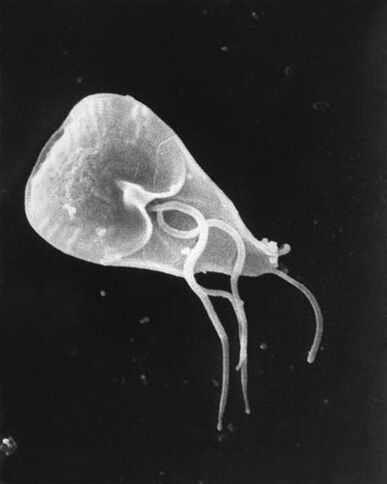Among the simplest organisms, there are many parasites of animals and humans. Listed below are the parasitic protozoa that cause the most serious and common diseases.
Amoeba dysentery
The dysentery amoeba is similar to the ordinary amoeba, but is smaller, and the rhizome is shorter and wider. It enters the human digestive system through the mouth during the cyst stage. In the large intestine, the amoeba leaves the cyst and feeds on bacteria without harming humans. In the future, this simplest creature will begin to invade the intestinal wall, feed on red blood cells and become parasites. Ulcers form in the intestines and consume the body. There is a disease of amebic dysentery, or amebiasis.
Dysentery amoeba can enter the blood and reach the liver. Here, parasites can also cause the formation of purulent ulcers.
Amoeba forms cysts and leaves the body with undigested food residues. Mild cysts can spread easily. If you don't wash your hands and don't wash your hands, you may get them.
Plasmodium malaria
Plasmodium is a parasitic protozoan. Certain types of malaria parasites can cause malaria in humans. The carrier of Plasmodium malaria is Anopheles mosquitoes. During insect bites, the malaria parasite enters the blood of the host. It reaches the liver along with the blood, where it eats, grows, and reproduces. After that, many malaria parasites enter the blood again and begin to parasitize on red blood cells, destroying them and releasing their waste products, thereby poisoning the host. A person has a fever and he suffers from anemia.
If a malaria patient is bitten by an Anopheles mosquito again, the malaria parasite will be transmitted from human to mosquito. In the body of the mosquito, the malaria parasite reproduces sexually.
Malaria is very common in Africa. This is a very dangerous disease. Fight against malaria, including the elimination of malaria mosquitoes.
Trypanosoma
Trypanosoma are parasitic protozoa with flagella (related to Euglena). Their main hosts are vertebrates, and insects are usually carriers. Different representatives of trypanosomes cause different diseases in animals and humans. They are mainly parasitic in the blood and cerebrospinal fluid. The most famous and common disease caused by trypanosomes is sleeping sickness.
The carrier of sleeping sickness is the tsetse fly. This disease is a typical disease in tropical Africa. The development of sleeping sickness is divided into two stages: a person suffers from fever and pain in the first few weeks, and sleepiness, sleep and coordination disturbances, and changes in consciousness occur one month or more later. This disease is easier to treat in the first stage.
Giardia
Giardia is a genus of parasitic flagellated protozoa. Intestinal ranella can cause giardiasis in humans and animals. This parasite lives in the small intestine.

A person is infected with Giardiasis by eating unwashed food containing Giardia cysts. Coming out of the cyst, Lamblia will stick to the intestines and feed on digested food.
Leishmania
Leishmania is another parasitic protozoan. They cause leishmaniasis in humans and many other animals. The vector is mosquitoes.
There are different types of leishmaniasis related to damage to various tissues of the body. One of them is the skin disease Pendinsky ulcer.
Coccidia
Coccidia parasites many animals, including worms, arthropods and fish. They cause coccidiosis and cause serious damage to livestock and fish farming.
Coccidia settle in the form of spores containing parasite cells.
Toxoplasma belongs to coccidia. Their representatives cause such a wide range of diseases in humans, such as toxoplasmosis. A person is infected by pets or undercooked meat. Toxoplasma gondii affects many organs, including the nervous system.



























